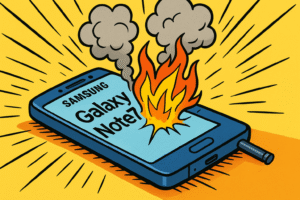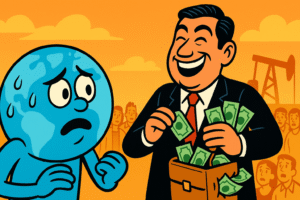Dieselgate Exposed: The True Story Behind Volkswagen Clean Diesel Scandal
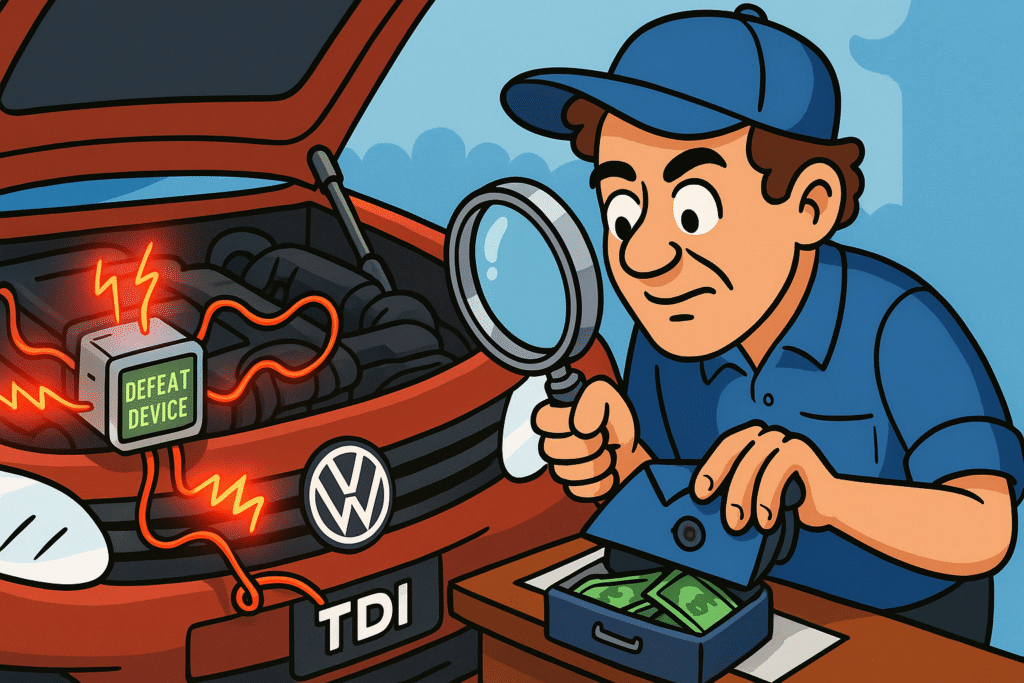
In the early 2000s, Volkswagen (VW) positioned its diesel-powered vehicles under the banner of “Clean Diesel,” marketing them in the U.S. as an environmentally friendly alternative to gasoline cars. This marketing push would later become infamous as the Volkswagen clean diesel scandal, when VW admitted to installing defeat devices that manipulated emissions tests. Initially, VW’s “Clean Diesel” campaign promised drivers superior fuel efficiency coupled with emissions comparable to—or even better than—those of gasoline engines, primarily by touting low nitrogen oxide (NOₓ) emissions as a hallmark of its technology (Wikipedia).
Nitrogen oxides, a collective term for NO and NO₂, are key precursors to ground-level ozone and fine particulate matter—pollutants linked to respiratory illnesses, cardiovascular disease, and premature death. Controlled human exposure and epidemiological studies have demonstrated that even short-term spikes in NO₂ can exacerbate asthma and increase hospital admissions for chronic obstructive pulmonary disease (COPD) (CARB).
Table of Contents
Background to Dieselgate
Volkswagen’s Rise in the U.S. Diesel Market
By 2009, Volkswagen had become the go-to choice for American drivers seeking diesel fuel economy without sacrificing performance.
- Sales boom: VW diesel sales jumped from about 256 000 units in 2010 to 468 000 in 2012 (GoodCarBadCar).
- “Clean Diesel” pitch: Advertisements touted diesel as both “green” and economical—“the best of both worlds”—emphasizing reduced emissions alongside better mileage (ScienceDirect).
U.S. Diesel Emissions Regulations (Pre-2015)
Before Dieselgate, U.S. rules relied entirely on laboratory tests—leaving a big gap between official figures and real-world tailpipe pollution.
Tier 2 Bin 5 Standard
- NOₓ cap: 0.07 g/mile under the FTP-75 federal test cycle.
Lab-Only Testing
- EPA’s protocols (40 CFR Part 1065) dictated dynamometer runs at fixed speeds, loads, and temperatures (EPA).
Real-World Gap
- No mandatory on-road or Real-Driving Emissions (RDE) checks, so cars could pass in the lab but pollute heavily on the street (The ICCT).
The Deception
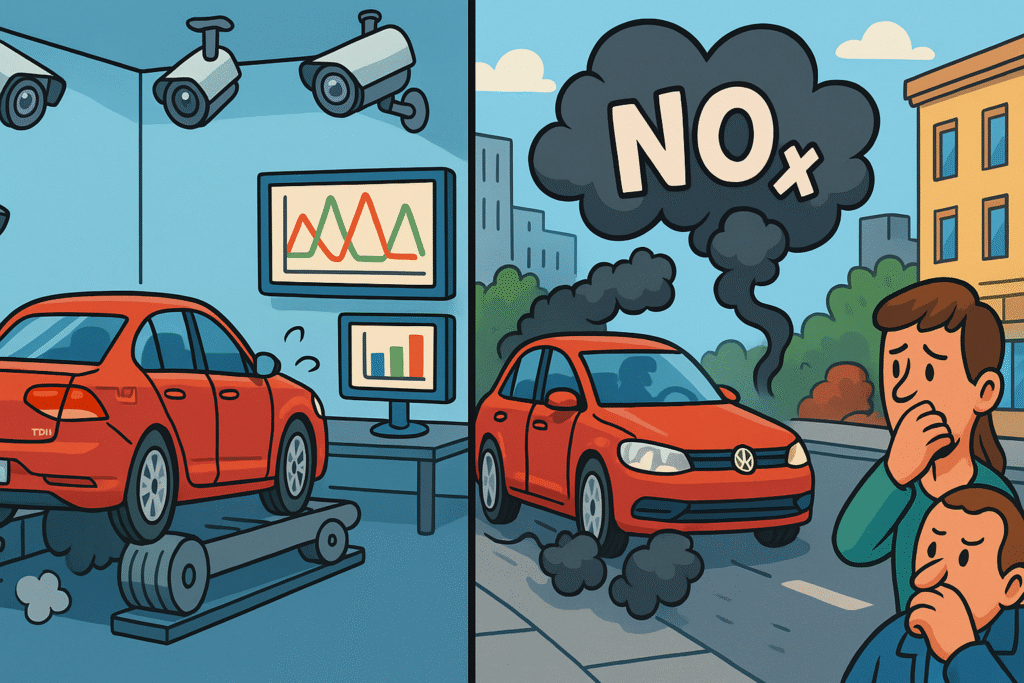
Installation of “Defeat Devices”
Between 2009 and 2015, VW equipped its EA189 diesel engines—in models like the Jetta, Beetle, Golf, and Audi A3—with hidden software designed to recognize official lab tests:
- Engine Control Unit (ECU) firmware monitored signals such as:
- Steering-wheel movement
- Constant vehicle speed
- Length of engine operation
- Barometric pressure
- Detection trigger: When these conditions matched the FTP-75 test cycle, the software switched on full emissions controls. Otherwise, it ran in a “performance” mode.
Learn more about the EA189 engine family on Wikipedia.
How the Software Worked
- Lab Mode
- Full SCR & EGR activation: Urea-based selective catalytic reduction (SCR) and exhaust gas recirculation (EGR) ran at maximum efficiency.
- NOₓ compliance: Vehicles easily met the EPA’s 0.07 g/mi limit.
- Road Mode
- Reduced controls: To boost fuel economy and power, the ECU throttled back SCR/EGR outside test conditions.
- Excess pollution: Real-world NOₓ emissions spiked—up to 40 × the legal limit.
Detailed analysis available at Wired.
Unveiling the Fraud
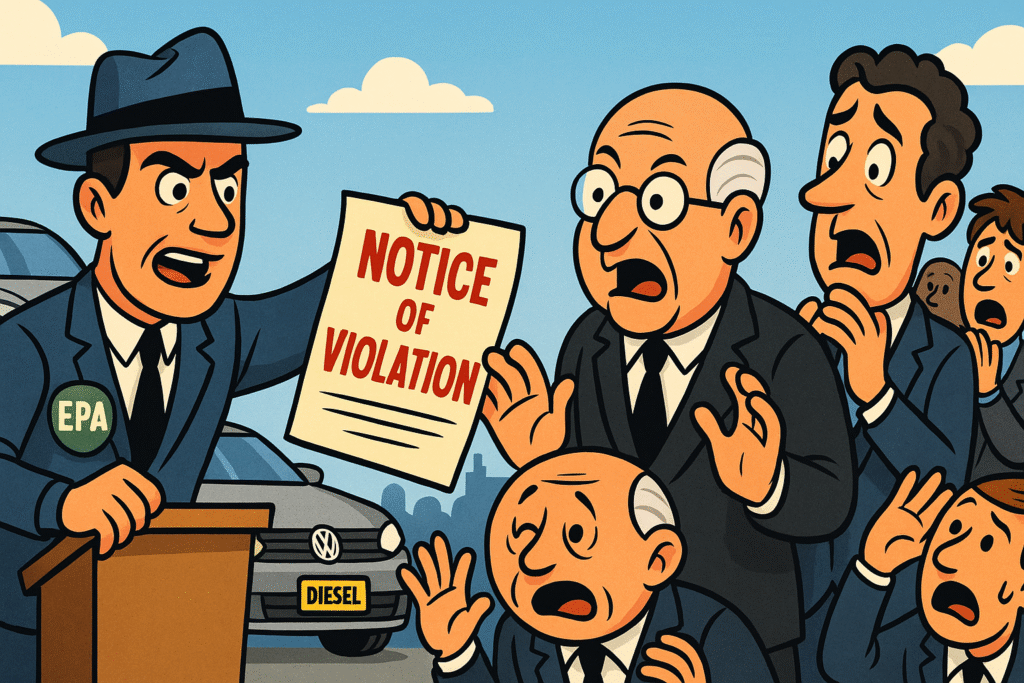
Key Events Leading to the EPA Notice
- September 18, 2015: After internal probes and third-party tests, the EPA and California Air Resources Board (CARB) issued a joint Notice of Violation, citing Volkswagen for Clean Air Act breaches.
- Scope of the NOV: Approximately 482,000 four-cylinder VW and Audi diesels (2009–2015) were flagged for illegal defeat devices.
Read the official notice on the EPA website and the CARB site.
Role of Independent Researchers
- West Virginia University’s CAFEE: In mid-2014, researchers from the Center for Alternative Fuels, Engines and Emissions (CAFEE) performed real-world tests on a VW Jetta diesel.
- Shocking Results: They recorded NOₓ emissions 15–35× higher than legal limits, data that formed the basis for the EPA’s 2015 enforcement action.
Discover their findings on WVU Today.
Scale and Impact
Quantifying Excess Emissions
- Lab vs. Road: VW’s “clean” diesels burned through the test cycle at 0.07 g/mi NOₓ, but on the open road they emitted ~2.8 g/mi—about 40× the legal limit (Wired).
- Annual Toll: With ~500 000 cars each doing ~10 000 mi/year, excess NOₓ likely topped 10 000 metric tons annually, fueling smog and fine-particle formation.
Detailed breakdown: Wired
Environmental & Health Consequences
- Respiratory Risks: Chronic NOₓ exposure worsens asthma, bronchitis, and COPD.
- Mortality Link: A 2020 WHO meta-analysis found every 10 ppb rise in annual NO₂ correlates with a 4–6% increase in all-cause mortality and more hospital visits for asthma/COPD.
- Hot-Spot Effects: Dieselgate’s worst impacts were felt in urban corridors with high VW diesel concentrations.
Read the WHO study: WHO.int
Legal and Financial Fallout
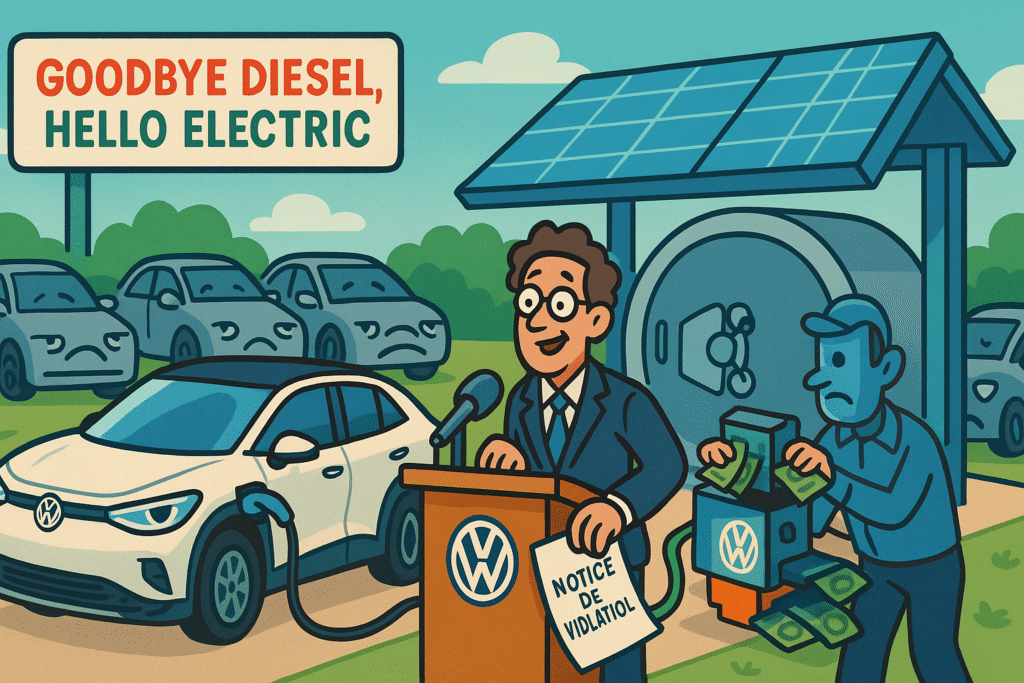
Lawsuits, Fines & Settlements
- U.S. Civil Settlement (June 2016): VW agreed to a $14.7 billion deal with the DOJ for vehicle buybacks, emissions recalls, and environmental cleanup.
- Owners could choose a buyback or approved repair + a $1,000 voucher.
- A $2.7 billion trust was set up for pollution–mitigation projects (Justice.gov).
- Europe and Beyond:
- €4.3 billion paid to German authorities.
- Multibillion-euro settlements across other EU countries.
- By 2021, total provisions had swelled to €31.3 billion (~$34.7 billion) (Reuters).
Impact on Leadership & Share Price
- CEO Shake-Up: Martin Winterkorn resigned days after the EPA/CARB notice.
- Financial Hit:
- 2014 operating profit: €14.4 billion
- 2015 operating loss: €4.2 billion, driven by €16.2 billion in diesel-related charges
- Stock Plunge: Shares fell nearly 50% between September and December 2015 before stabilizing on cost cuts and EV investment (VW 2015 Annual Report).
Regulatory and Industry Response
Tighter Testing Protocols
- Real-Driving Emissions (RDE): Regulators worldwide introduced on-road checks using Portable Emission Measurement Systems (PEMS).
- EPA In-Use Testing: Expanded field audits to ensure lab results matched road performance.
- EU Updates: Adopted the Worldwide Harmonized Light Vehicles Test Procedure (WLTP) and RDE mandates for Euro 6d standards (EPA.gov).
Shift Away from Diesel
- Electrification Push: Automakers fast-tracked EV programs; VW rebranded as “Volkswagen of Tomorrow,” committing $86 billion to electrification by 2025 and launching the ID. series as its EV flagship (New York Post).
- Market Impact: U.S. diesel market share collapsed from 5% (2014) to < 2% (2016).
Lessons Learned
The Dieselgate scandal highlighted a critical need for real-world emissions testing. Relying solely on laboratory cycles creates loopholes that manufacturers can exploit, so regulators and carmakers alike must embrace on-road checks such as Real-Driving Emissions (RDE) tests with portable measurement systems (PEMS) to ensure vehicles perform as cleanly on the street as they do in the lab (The ICCT).
Equally important is fostering an ethical engineering culture within automotive firms. Transparency and accountability should be built into every stage of software development—ideally through mandatory third-party audits of ECU firmware—to catch any hidden “defeat-device” logic before cars reach consumers. For guidance on secure automotive software practices, see the SAE guidelines.
Corporate governance must also evolve to balance profitability with environmental and social responsibility. Boards and R&D teams need clear metrics that incentivize ethical behavior, not just sales targets. Initiatives like the EU’s Corporate Sustainability Reporting Directive offer useful frameworks for integrating sustainability into corporate reporting (European Commission).
Finally, penalties for non-compliance must be steep enough to deter wrongdoing. VW’s own multi-billion-dollar settlements underscore how costly regulatory breaches can become; enhancing civil and criminal liabilities under policies such as the EPA’s Tier 3 civil penalty provisions sends a powerful deterrent message (EPA).
Conclusion
A decade after the EPA’s Notice of Violation, the Volkswagen “Clean Diesel” scandal remains a watershed moment in automotive history. It forced governments around the world to tighten emissions oversight, ushering in rigorous on-road testing protocols and laying the groundwork for more transparent corporate practices.
While diesel power isn’t vanishing—especially in heavy-duty sectors—the scandal undeniably accelerated the industry’s shift toward zero-emission mobility. As automakers invest billions in electric vehicle platforms, the lessons from Dieselgate serve as a reminder that only robust regulations and ethical innovation can keep us on the road to cleaner air.
FAQ: Volkswagen Clean Diesel Scandal
What did Volkswagen mean by “Clean Diesel”?
Volkswagen branded its 2009–2015 TDI models as “Clean Diesel,” claiming they combined diesel’s fuel efficiency with ultra-low NOₓ emissions to meet EPA standards—positioning diesel as a green alternative to gasoline cars.
How did VW’s defeat devices operate?
VW’s EA189 engines contained ECU software that detected the FTP-75 lab test by monitoring steering angle, speed stability, runtime, and barometric pressure. During tests, full SCR and EGR emissions controls were enabled; in normal driving, controls were scaled back to boost performance, resulting in NOₓ emissions up to 40× the legal limit (Wired).
Who exposed the excess NOₓ emissions?
In mid-2014, West Virginia University’s CAFEE lab performed on-road testing of a VW Jetta diesel, finding NOₓ outputs 15–35× above EPA limits. Their September 2015 publication prompted the EPA and CARB to investigate (WVU Today).
How many vehicles were affected?
Approximately 482,000 VW and Audi four-cylinder diesel cars sold in the U.S. from model years 2009–2015 were fitted with the illegal defeat-device software (EPA).
What were the environmental and health impacts?
Those vehicles emitted an estimated 10,000+ metric tons of extra NOₓ annually—fueling smog and particulate formation. Chronic NOₓ exposure is linked to asthma aggravation, COPD hospitalizations, and a 4–6% rise in all-cause mortality per 10 ppb increase in NO₂ (WHO).
What legal settlements did VW face?
In June 2016, VW agreed to a $14.7 billion U.S. settlement with the DOJ for buybacks, repairs, and remediation, plus a $2.7 billion environmental trust. European fines and provisions brought total costs to over €31.3 billion by 2021 (Justice.gov; Reuters).
How did Dieselgate affect VW’s leadership and finances?
CEO Martin Winterkorn resigned days after the 2015 NOV. VW’s operating profit swung from €14.4 billion (2014) to a €4.2 billion loss (2015) due to €16.2 billion in diesel-related charges, and its share price plunged nearly 50% in late 2015 (VW 2015 Annual Report).
What regulatory changes followed?
Regulators adopted real-driving emissions (RDE) tests with PEMS alongside lab cycles. The EU rolled out WLTP and RDE for Euro 6d vehicles, and the EPA expanded in-use compliance testing to prevent lab-only manipulation (EPA).
How did the scandal reshape the auto industry?
U.S. diesel market share fell from ~5% (2014) to <2% (2016). Automakers accelerated electric vehicle programs; VW committed $86 billion to electrification by 2025 and launched its ID. EV lineup to regain consumer trust (New York Post).
What lessons does Dieselgate teach?
Real-World Testing: Mandate RDE/PEMS checks to match lab and road performance.
Ethical Engineering: Enforce transparent software audits to catch defeat-device logic.
Strong Governance: Balance profits with environmental responsibility via clear sustainability metrics.
Deterrent Penalties: Impose steep fines and criminal liabilities to discourage future misconduct.
References
- GoodCarBadCar. “Volkswagen U.S. Sales Statistics.” https://www.goodcarbadcar.net/volkswagen-us-sales-statistics/
- ScienceDirect. “Environmental and Economic Benefits of Diesel Fuel.” https://www.sciencedirect.com/science/article/pii/S1361920913002169
- U.S. Environmental Protection Agency. “Emission Standards Reference Guide: Light-Duty Vehicles.” https://www.epa.gov/emission-standards-reference-guide/epa-emission-standards-light-duty-vehicles
- International Council on Clean Transportation. “Real-World vs. Lab-Tested Emissions: Closing the Gap.” https://theicct.org/publications/ldv-road-emissions-testing-gaps
- Wikipedia. “Volkswagen Emissions Scandal (EA189 Engine).” https://en.wikipedia.org/wiki/Volkswagen_emissions_scandal
- Wired. “How Volkswagen’s ‘Clean Diesel’ Left Us in the Smog.” https://www.wired.com/story/volkswagen-diesel-emissions-scandal-explained/
- WVU Today. “WVU Researchers Uncover Excess VW Emissions.” https://wvutoday.wvu.edu
- U.S. Department of Justice. “Volkswagen Civil Settlement.” https://www.justice.gov
- Reuters. “Volkswagen’s Diesel Scandal Costs Soar to €31.3 Billion.” https://www.reuters.com
- Volkswagen AG. “2015 Annual Report.” https://www.volkswagenag.com/en/InvestorRelations/Publications.html
- New York Post. “VW’s Electric Pivot: $86 Billion Bet on E-Cars.” https://nypost.com
- World Health Organization. “Ambient (Outdoor) Air Pollution and Health.” https://www.who.int/news-room/fact-sheets/detail/ambient-(outdoor)-air-quality-and-health
- SAE International. “Standards for Secure Automotive Software Development.” https://www.sae.org/standards/
- European Commission. “Corporate Sustainability Reporting Directive (CSRD).” https://ec.europa.eu/info/business-economy-euro/company-reporting-and-auditing/company-reporting/corporate-sustainability-reporting_en
- U.S. Environmental Protection Agency. “Clean Air Act Civil Penalty Policies.” https://www.epa.gov/enforcement/penalties-clean-air-act

